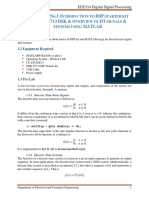LAB 6: P /E S S P: Ower Nergy of The Ignals and Ystem Roperties
LAB 6: P /E S S P: Ower Nergy of The Ignals and Ystem Roperties
Uploaded by
ahmedCopyright:
Available Formats
LAB 6: P /E S S P: Ower Nergy of The Ignals and Ystem Roperties
LAB 6: P /E S S P: Ower Nergy of The Ignals and Ystem Roperties
Uploaded by
ahmedOriginal Description:
Original Title
Copyright
Available Formats
Share this document
Did you find this document useful?
Is this content inappropriate?
Copyright:
Available Formats
LAB 6: P /E S S P: Ower Nergy of The Ignals and Ystem Roperties
LAB 6: P /E S S P: Ower Nergy of The Ignals and Ystem Roperties
Uploaded by
ahmedCopyright:
Available Formats
LAB 6: POWER/ENERGY OF THE SIGNALS AND SYSTEM
PROPERTIES
CLO5: USE MODERN TOOL (E.G. MATLAB) FOR SIGNAL REPRESENTATION,
VISUALIZATION AND PROCESSING IN BOTH TIME AND FREQUENCY DOMAIN.
Function Handle
A function handle is a MATLAB data type that holds information to be used referencing a function.
When you create a function handle, MATLAB captures all the information about the function that it
needs to execute it later on. Once the handle is created, it can be used to execute the function at any
time.
Function handles are defined using the @ operator. Consider the following example:
>> f = @(x) x^5-3*x
f =
function_handle with value:
@(x)x^5-3*x
This tells MATLAB to create a function for which x is the variable (this is what the @(x) does) and
for which the rule is x^2-x. Here are some things we can do with function handles. We can plug things
in:
>> f(3)
ans =
234
Differentiation and Integration
We cannot simply do diff(f) because diff doesn't work as-is on function handles. However, if we define
x as symbolic then Matlab will accept diff. What's happening here is that f is a function handle but
f(x) is symbolic because symbolic x is plugged in:
>> clear all;
>>f = @(x) x^5-3*x;
>>syms x;
>>diff(f(x))
ans =
5*x^4 - 3
MCT-301L: Signals and Systems
Department of Mechatronics and Control Engineering, U.E.T Lahore
AND
>>diff(f(x),2)
ans =
20*x^3
Also, provided x is symbolically defined then the following will work:
>>diff(f,x,2)
ans =
20*x^3
Integration works the same way in that int(f) and int(f,1,2) will work provided x is symbolic:
>>clear all;
>>f = @(x) x^5-3*x;
>>syms x;
>>int(f(x))
ans =
(x^2*(x^4 - 9))/6
AND
>>int(f(x),1,2)
ans = 6
will work fine, as will:
>>int(f,x,1,2)
ans = 6
MCT-301L: Signals and Systems
Department of Mechatronics and Control Engineering, U.E.T Lahore
Calculate Power and Energy of a Signal:
The power of signal (with independent time variable n) is given by the averaging the summation:
𝑛=𝑁
1
𝑃(𝑥[𝑛]) = 𝑙𝑖𝑚 ∑ |𝑥[𝑛]|2
𝑁→∞ 2𝑁 + 1
𝑛=−𝑁
while energy is:
𝑛=𝑁
𝐸(𝑥[𝑛]) = 𝑙𝑖𝑚 ∑ |𝑥[𝑛]|2
𝑁→∞
𝑛=−𝑁
While it is easier to implement summation, the limit part is implemented by setting N to some number
e.g. 100 or 1000 and then increasing it gradually. When N is steadily increased, if the power of the
signal approaches constant value while its energy keeps increasing, it is a power signal. On the other
hand, if the energy of signal approaches constant value and its power approaches zero, it is energy
signal. Otherwise the signal can be classified as neither power nor energy signal.
TASK 1:
Calculate power and the energy of the following signals and classify them as power signal, energy
signal or neither power nor energy signal. You have to plot the Power and Energy graph and
also find the mean Power and Energy:
𝜋 𝜋
a) 𝑐𝑜𝑠 ( 5 𝑛 − 15)
b) 0. 8|𝑛|
2𝜋
c) 𝑒 𝑗 10 𝑛
d) (−1)𝑛
𝑛
𝜋
e) 𝑒 100 𝑐𝑜𝑠 (6 𝑛)
y = @ (n) cos (n); %Replace cos(n) with
N = 100;
for i = 1:1000
P (i) = 0 ; E (i) = 0;
for m = -N:N
%Complete the Logic
end
P (i) = %Complete the Logic
N = N + 10;
end
i = 1: 1000;
mean (P)
mean (E)
subplot (2, 1, 1); plot (i,P,'r');
xlabel ('N'); ylabel ('Power');
subplot (2, 1, 2);
plot (i,E,'g');
xlabel ('N'); ylabel ('Energy');
TASK 2:
Repeat Task 1 for Continuous-Time signals.
MCT-301L: Signals and Systems
Department of Mechatronics and Control Engineering, U.E.T Lahore
Verifying System Properties:
Task 3:
Consider the discrete-time system y[n] = n x[n]. Use MATLAB to verify whether the system is Time
Invariant or not.
a. Assume that the input to this system is x[n] = u[n]-u[n-4].
b. Sketch the input x[n].
c. Sketch the output y[n] for input x[n].
d. Let x1[n] = x[n-2]. Sketch the input x1[n].
e. Sketch the output y1[n] for input x1[n].
f. Sketch the output y[n-2].
g. Is the output y1[n] equal to y[n-2]? Is system TI?
Task 4:
Repeat Task3 for the system y[n] = (x[n+1] + x[n] + x[n-1])/3 (It is moving average filter with M=1)
MCT-301L: Signals and Systems
Department of Mechatronics and Control Engineering, U.E.T Lahore
You might also like
- 109080-q Smart Cell - Bilge - ManualDocument29 pages109080-q Smart Cell - Bilge - Manualabuzer1981No ratings yet
- DSP Assignment 1 SolutionDocument7 pagesDSP Assignment 1 SolutionHasnain KhanNo ratings yet
- Introduction To Discrete-Time Signals: InstructionsDocument14 pagesIntroduction To Discrete-Time Signals: InstructionsM Hassan BashirNo ratings yet
- Lab 2 DSP. Linear Time-Invariant SystemDocument15 pagesLab 2 DSP. Linear Time-Invariant SystemTrí TừNo ratings yet
- El-312 Lab Manual+ListDocument76 pagesEl-312 Lab Manual+ListImran AliNo ratings yet
- Lab 3 - Operations On SignalsDocument8 pagesLab 3 - Operations On Signalsziafat shehzadNo ratings yet
- Signals & Systems Lab.-ManualDocument15 pagesSignals & Systems Lab.-ManualsibascribdNo ratings yet
- 2019ee76 - LAB4 DSPDocument12 pages2019ee76 - LAB4 DSPHamna Hamna AsiffNo ratings yet
- 2019ee76 - LAB4 DSPDocument12 pages2019ee76 - LAB4 DSPHamna Hamna AsiffNo ratings yet
- Experiment No.1 I DSP TMS320C6713 DSK & O DT & Matlab: Lab Manual EEE324 Digital Signal ProcessingDocument14 pagesExperiment No.1 I DSP TMS320C6713 DSK & O DT & Matlab: Lab Manual EEE324 Digital Signal ProcessingMirza Riyasat AliNo ratings yet
- Experiment No.1 I DSP TMS320C6713 DSK & O DT & Matlab: Lab Manual EEE324 Digital Signal ProcessingDocument27 pagesExperiment No.1 I DSP TMS320C6713 DSK & O DT & Matlab: Lab Manual EEE324 Digital Signal ProcessingMirza Riyasat AliNo ratings yet
- Assignment 1Document3 pagesAssignment 1mertdene10No ratings yet
- DSP Fundamentals Lecture Note Set #4 More Operations Involving One or Two SignalsDocument5 pagesDSP Fundamentals Lecture Note Set #4 More Operations Involving One or Two SignalsZaid Al-AlshaikhNo ratings yet
- Exp 3Document9 pagesExp 3Mohammad HasnainNo ratings yet
- Chapter - 2 PDFDocument11 pagesChapter - 2 PDFgebretsadkan abrhaNo ratings yet
- ANINON, RG. - EcE 224 Lab Report 2Document41 pagesANINON, RG. - EcE 224 Lab Report 2Rica AniñonNo ratings yet
- Final Project: Power MethodDocument9 pagesFinal Project: Power MethodZhijie TangNo ratings yet
- PCS Lab-3Document8 pagesPCS Lab-3Fatima IsmailNo ratings yet
- 2021 - Praktikum DinSis - Modul 4Document6 pages2021 - Praktikum DinSis - Modul 4ok dokterNo ratings yet
- Matlab File RituDocument9 pagesMatlab File Rituvipako9305No ratings yet
- Lab 05 PDFDocument7 pagesLab 05 PDFAbdul Rehman AfzalNo ratings yet
- DSP EXP. 5 SolutionDocument10 pagesDSP EXP. 5 Solution01haval 10No ratings yet
- LAB 6 - Analysis of LTI Systems in the z-DomainDocument14 pagesLAB 6 - Analysis of LTI Systems in the z-DomainJahanzaib RanaNo ratings yet
- DSP Manual Autumn 2011Document108 pagesDSP Manual Autumn 2011Ata Ur Rahman KhalidNo ratings yet
- EE39203 Aut2022 Exp2Document6 pagesEE39203 Aut2022 Exp2Bharat UdayNo ratings yet
- Laboratory 1: Discrete-Time Signals in MATLABDocument8 pagesLaboratory 1: Discrete-Time Signals in MATLABWaleed SaeedNo ratings yet
- Matlab Review PDFDocument19 pagesMatlab Review PDFMian HusnainNo ratings yet
- Exam2-Problem 1 Part (A)Document15 pagesExam2-Problem 1 Part (A)syedsalmanali91100% (1)
- Practice 6 8Document12 pagesPractice 6 8Marisnelvys CabrejaNo ratings yet
- MATLab Tutorial #5 PDFDocument7 pagesMATLab Tutorial #5 PDFsatyamgovilla007_747No ratings yet
- Micro-Chaos in Digital Control: Summary. in This Paper We Analyze A Model For The Effect of Digital Control On OneDocument34 pagesMicro-Chaos in Digital Control: Summary. in This Paper We Analyze A Model For The Effect of Digital Control On OneGeorge HallerNo ratings yet
- Module-1 Eeng 482 Signal and SystemsDocument17 pagesModule-1 Eeng 482 Signal and SystemsMackdonald ShiwaniNo ratings yet
- Sample Viva QuestionsDocument30 pagesSample Viva QuestionsNumanAbdullahNo ratings yet
- Lab 2-CS-Lab-2020Document12 pagesLab 2-CS-Lab-2020Lovely JuttNo ratings yet
- Signals and Systems Using MatlabDocument68 pagesSignals and Systems Using MatlabSavio S100% (6)
- Matlab ManualDocument90 pagesMatlab ManualSri Harsha57% (7)
- NMK31003 DSP Lab 2 Module For Sem 2 2023 - 24Document9 pagesNMK31003 DSP Lab 2 Module For Sem 2 2023 - 24kajojim206No ratings yet
- Lab 8Document13 pagesLab 8naimoonNo ratings yet
- ENGM541 Lab5 Runge Kutta SimulinkstatespaceDocument5 pagesENGM541 Lab5 Runge Kutta SimulinkstatespaceAbiodun GbengaNo ratings yet
- MatlabDocument41 pagesMatlabNour BishadyNo ratings yet
- Exercise 1 Instruction PcaDocument9 pagesExercise 1 Instruction PcaHanif IshakNo ratings yet
- Calculus Memorial Trabalho 4Document7 pagesCalculus Memorial Trabalho 4j.salamancaNo ratings yet
- MATLab Tutorial #5 PDFDocument7 pagesMATLab Tutorial #5 PDFSteveNo ratings yet
- Lcs Exp4 SolvedDocument16 pagesLcs Exp4 SolvedLaiba YousafNo ratings yet
- Convolve TutorialDocument7 pagesConvolve TutorialyowhatsuptNo ratings yet
- Lab 3-CS-LabDocument12 pagesLab 3-CS-Labهاشمی دانشNo ratings yet
- Discrete-Time Signals and Systems: Gao Xinbo School of E.E., Xidian UnivDocument40 pagesDiscrete-Time Signals and Systems: Gao Xinbo School of E.E., Xidian UnivNory Elago CagatinNo ratings yet
- Linear Time Invariant Systems: (N), and IsDocument12 pagesLinear Time Invariant Systems: (N), and IsKashif AbbasNo ratings yet
- SS Question BankDocument134 pagesSS Question Bankpavithrabio20No ratings yet
- 1 Lab Manual-Final-Control-System-1Document35 pages1 Lab Manual-Final-Control-System-1Shimalis RetaNo ratings yet
- Divyansh Signal File.. (2) - CombinedDocument27 pagesDivyansh Signal File.. (2) - CombinedDivyansh YadavNo ratings yet
- EXPE7Document10 pagesEXPE7rk7670855No ratings yet
- NA FinalExam Summer15 PDFDocument8 pagesNA FinalExam Summer15 PDFAnonymous jITO0qQHNo ratings yet
- Ex 4 (MPC)Document5 pagesEx 4 (MPC)sergioNo ratings yet
- HomeworkDocument6 pagesHomeworksrosphouNo ratings yet
- SNS Lab14Document12 pagesSNS Lab14I190845 Samana NayyabNo ratings yet
- Student Solutions Manual to Accompany Economic Dynamics in Discrete Time, second editionFrom EverandStudent Solutions Manual to Accompany Economic Dynamics in Discrete Time, second editionRating: 4.5 out of 5 stars4.5/5 (2)
- A Brief Introduction to MATLAB: Taken From the Book "MATLAB for Beginners: A Gentle Approach"From EverandA Brief Introduction to MATLAB: Taken From the Book "MATLAB for Beginners: A Gentle Approach"Rating: 2.5 out of 5 stars2.5/5 (2)
- Student's Solutions Manual and Supplementary Materials for Econometric Analysis of Cross Section and Panel Data, second editionFrom EverandStudent's Solutions Manual and Supplementary Materials for Econometric Analysis of Cross Section and Panel Data, second editionNo ratings yet
- User GuideDocument206 pagesUser GuidePetya Kirilova ManevaNo ratings yet
- Brochure Pattern 001Document21 pagesBrochure Pattern 001Mohd Azhar AbdullahNo ratings yet
- Nikolaos MesaritesDocument87 pagesNikolaos MesaritesleipsanothikiNo ratings yet
- Collins URG-IV DsDocument2 pagesCollins URG-IV DsMarco PoloNo ratings yet
- Catalinas ManualDocument192 pagesCatalinas ManualFabián CarguaNo ratings yet
- Toeic B - Session 4Document40 pagesToeic B - Session 4Nga ThuNo ratings yet
- PhysicsDocument21 pagesPhysicsedomjapiNo ratings yet
- Glossary For BiologyDocument18 pagesGlossary For BiologyPershernNo ratings yet
- Why Apple Utilizes Key Performance Indicators KPIDocument8 pagesWhy Apple Utilizes Key Performance Indicators KPINOOR AZLINA SAMAHNo ratings yet
- B.SC (Internet and Mobile Technologies)Document56 pagesB.SC (Internet and Mobile Technologies)Unify SoftTechNo ratings yet
- School Management System Project Report in JavaDocument2 pagesSchool Management System Project Report in JavaRoyet Gesta Ycot Camay0% (1)
- Gen Chem 2 Q2 Module 14Document19 pagesGen Chem 2 Q2 Module 14Evelyn AndosonNo ratings yet
- Consent Form APAAR Modified ApprovedDocument1 pageConsent Form APAAR Modified Approvedneerasingh30872100% (2)
- Chap 1Document6 pagesChap 1Vuong Hoang Ngoc My (K18 HCM)No ratings yet
- 逆三角函数积分作业Document8 pages逆三角函数积分作业afmofaazdNo ratings yet
- Cet401 Design of Steel Structures, December 2023Document3 pagesCet401 Design of Steel Structures, December 2023neds74099No ratings yet
- ThedynamicnewworkplaceDocument58 pagesThedynamicnewworkplaceMarry Joe BenicoNo ratings yet
- Johannes Trithemius: The Art of Drawing Spirits Into CrystalsDocument6 pagesJohannes Trithemius: The Art of Drawing Spirits Into CrystalsFrederich De MoyanoNo ratings yet
- NovuX Connector Closure BR-113399-ENDocument8 pagesNovuX Connector Closure BR-113399-ENAdel TigziriaNo ratings yet
- Appeals TableDocument7 pagesAppeals TableDanielle Sophia GardunoNo ratings yet
- Detailed Lesson Plan in Science 5Document8 pagesDetailed Lesson Plan in Science 5ka travelNo ratings yet
- Reading Food Labels: Heinz-Christopher U. ElordeDocument14 pagesReading Food Labels: Heinz-Christopher U. ElordeRamon GasgasNo ratings yet
- Isomerism 01 - Class Notes - (JEE Ultimate CC 2023)Document53 pagesIsomerism 01 - Class Notes - (JEE Ultimate CC 2023)Prakhar PatelNo ratings yet
- Antenna Temperature Radar Ch-12 Kraus BookDocument37 pagesAntenna Temperature Radar Ch-12 Kraus BookAmal EiraNo ratings yet
- Lars Luettge Rig PackDocument2 pagesLars Luettge Rig PackNiXiN0% (1)
- All Summer in A Day RTCDocument6 pagesAll Summer in A Day RTCHarshwardhan UndeNo ratings yet
- Book List S6Document5 pagesBook List S6Anna WangNo ratings yet
- G5B2 AmazingOctopus Level 3-1rnbm7sDocument3 pagesG5B2 AmazingOctopus Level 3-1rnbm7scan tokcanNo ratings yet
- Theory of Machines: Belt, Rope and PulleyDocument18 pagesTheory of Machines: Belt, Rope and PulleyRabia ZulqarnainNo ratings yet

























































































